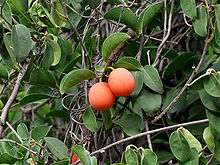Ximenia americana
| Ximenia americana | |
|---|---|
 | |
| Scientific classification | |
| Kingdom: | Plantae |
| (unranked): | Angiosperms |
| (unranked): | Eudicots |
| (unranked): | Core eudicots |
| Order: | Santalales |
| Family: | Olacaceae |
| Genus: | Ximenia |
| Species: | X. americana |
| Binomial name | |
| Ximenia americana | |
Ximenia americana, commonly known as tallow wood,[1] yellow plum, sea lemon, or pi'ut (Chamorro),[2] is a small sprawling tree of woodlands native to the tropics.
Leaves are oval shaped, bright green and have a strong smell of almonds. Flowers are pale in color. Fruits are lemon-yellow or orange-red.[3]
Uses
As food
The fruits have a pleasant plum-like flavor. In Asia, the young leaves are cooked as a vegetable. However, the leaves also contain cyanide and need to be thoroughly cooked, and should not be eaten in large amounts.
In medicine
Ximenia americana was investigated by researchers from Nigeria's Ahmadu Bello University. In animal tests, it has shown some effect against the parasite that causes sleeping sickness and severe anaemia in livestock in many parts of Africa. The leaf extract is active against Escherischia coli, Pseudomonas aeruginosa and Candida albicans. Tannins, flavonoids, alkaloids, saponins, anthraquinones, and general glycosides were found in the extract.[4] Indigenous people of Florida used the bark to treat sore muscles and gums.[5]
The root also contains the fatty acids tariric acid and 10Z,14E,16E-octadeca-10,14,16-triene-12-ynoic acid.[6]
References
- ↑ "Ximenia americana". Natural Resources Conservation Service PLANTS Database. USDA. Retrieved 7 August 2015.
- ↑ Raulerson, L., & A. Rinehart. Trees and Shrubs of the Mariana Islands. 1992.
- ↑ Low, T., Wild Food Plants of Australia, 1991. ISBN 0-207-16930-6
- ↑ Short Communication: Studies of antimicrobial activity and chemical constituents of Ximenia americana. DS Ogunleye and SF Ibitoye, Trop J Pharm Res, December 2003, 2(2), pages 239-241 (abstract)
- ↑ 50 Common Native Plants Important In Florida's Ethnobotanical History by Ginger M. Allen, Michael D. Bond, and Martin B. Main. University of Florida IFAS Extension. http://edis.ifas.ufl.edu/uw152
- ↑ C18 Acetylenic Fatty Acids of Ximenia americana with Potential Pesticidal Activity. Majekodunmi O. Fatope, Oumar A. Adoum and Yoshio Takeda, J. Agric. Food Chem., 2000, 48 (5), pages 1872–1874, doi:10.1021/jf990550k
External links